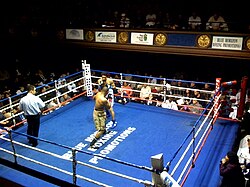The Blue Horizon
 |
|
| Address | 1314 N. Broad Street |
|---|---|
| Location | Philadelphia, Pennsylvania |
| Coordinates | 39°58′26″N 75°09′34″W / 39.9739°N 75.1594°WCoordinates: 39°58′26″N 75°09′34″W / 39.9739°N 75.1594°W |
| Capacity | 1,500 |
| Opened | November 3, 1961 |
| Closed | June 2010 |
The Blue Horizon is a historic 1,500-seat former boxing venue in Philadelphia. The Ring magazine voted it the number-one boxing venue in the world, and Sports Illustrated noted it as the last great boxing venue in the country.
The Blue Horizon was originally constructed as three four-story Second Empire style houses in 1865. Originally built to house the nouveau riche, the properties were eventually sold to the Loyal Order of Moose. Architect Carl Berger oversaw the 1914 alterations to house the fraternal lodge, adding a ballroom, bar, and auditorium. Lodge #54, located at 1312-1316 North Broad Street had over 20,000 members by 1920, at that point the highest membership of any fraternal lodge in the world. By the late 1920s, membership had reached over 40,000 and plans were made for an extensive expansion of the building; however the Great Depression forced Lodge #54 to abandon their plans. The building also got its first taste of professional boxing during the Moose era, with two fight cards on March 1 and March 28 of 1938. The March 28th card featured heavyweight Willie Reddish, who later trained Sonny Liston and Joe Frazier.
Jimmy Toppi Sr. purchased the building in 1961 for $85,000, and renamed it after the song "Beyond the Blue Horizon" from the 1930 film Monte Carlo. After another series of renovations, regular boxing shows began in the Blue Horizon on November 3, 1961. The main event featured Hall of Famer George Benton against Chico Corsey, a late substitute. The early days of the building as a boxing venue saw regular weekly shows. Promoter Marty Kramer was given a grant from Madison Square Garden to put on these matches in order to develop young fighters. Kramer promoted over 30 main events before leaving the Blue Horizon in 1963. Promoter Herman Taylor then hosted three nationally televised bouts at the venue in 1963 and 1964, featuring Jose Stable, Dick Turner, Harold Johnson, Henry Hank, Stanley Hayward, and Curtis Cokes. On May 26, 1966 "Gypsy" Joe Harris took a 10 round decision over Johnny Knight in a fight promoted by Lou Lucchese. There would be no more fights until September 30, 1969, when J. Russell Peltz had his first promotion of his Hall of Fame career. Peltz set a site attendance record of 1,606 in his first of many cards at the Blue Horizon. Peltz would leave the Blue in 1971 after 31 cards to promote at bigger venues like the Spectrum, but would return in 1974. Peltz would promote more fights at the Blue Horizon than anyone else in its history. The Peltz era brought Philadelphia greats such as Matthew Saad Muhammad, Bernard Hopkins, Cyclone Hart, Tim Witherspoon, and Bennie Briscoe. Peltz left the Blue Horizon in 2001, came back to promote one card in 2004 and three card in 2009 for the last time.
...
Wikipedia
